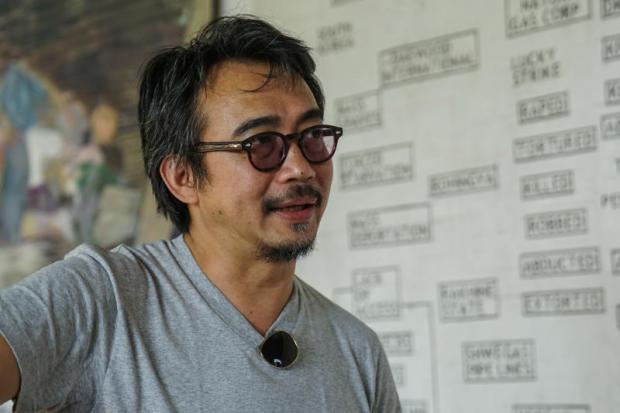Sawangwongse Yawnghwe has lived the life of an exile. A celebrated Shan artist, Sawangwongse channels his experience into paintings and installations that bring to the table issues pertaining to a large spectrum of political views.
Residing between Chiang Mai and Zutphen, the Netherlands, the 47-year-old has been prolific, and his work has been showcased in various international galleries, earning him fame for the knack with which he shares his conflicted past. Some of his works are being shown at Gwanju Biennale, an art show in South Korea which has Thai curator Gridthiya Gaweewong on the artistic team. The theme for this year, fittingly for Sawangwongse, is "Imagined Borders".
His latest exhibition: Sawangwongse Yawnghwe - Bullet school was held at H Gallery, Bangkok on September 1st.
Sawangwongse's biography is marked by violent episodes interspersed among the history of Southeast Asia. He is not only the grandson of Burma's first -- and ousted -- president, but his surname comes from the name of the Shan state where his grandfather, Sao Shwe Thaike, once ruled as Saopha, a hereditary royal title meaning Lord of the Sky.
He was born in a Shan State Army (SSA) camp in Shan State, Burma. However, he was initially raised in Thailand before his family fled as exiles to Canada after a spate of assassinations. It does not come as a surprise that Sawangwongse's paintings and installations often intertwine the personal and the political, with reference to his family history as well as current and historical events in Myanmar.
Walk us through your thought process when you start a new series of paintings for an exhibition.
My process is completely intuitive. I am against academic practice, as I am against contemporary practice, which I think has its roots in the market economy. Usually I don't work on exhibitions or guidelines of curators; the works or series start from the need to archive the Shan State's disappearing history, a reaction against the nationalist chauvinism. I don't claim to speak for the Shan people, per se, but what I say is in my artwork. The Shan people also would likely say [the same things] in their daily life, which is basically that we want the right to self-determination and to be free.
I struggle with my work just like any labourer -- there is essentially no difference between painting and manual labour. The challenge is of course making good work, which is never guaranteed.
You reflect on ethnic minorities, political strife and other issues along this line.
I hope that I am able to give voice to the invisible. Among the Shan people or any other ethnic minority, I am privileged to be able to get out of the system, which I cannot say for 99% of the people. Although as an exile, which basically means an immigrant in Canada, life was not that peachy. I grew up in poverty, my mother and father had to do manual labour to earn a living. I remember someone suggested to my mother that she could work at a slaughterhouse. My mother worked hard which took its toll on her physically while my father went back to school to pursue his PhD in political science.
Please tell us how it has been to live the life of a Shan exile/artist.
My roots were ripped out from underneath. I knew nothing of what it means to be a Shan. I was a refugee, an immigrant, an outsider, an FOB -- fresh off the boat. Even when I was growing up in Thailand, it wasn't safe to be who I was -- I had to assume the identity of a Thai. Then by the age of 12, we immigrated to Canada, where I was at a loss as to who I was. So the idea of exile is retrospective -- that is to say, I was only aware of it after the fact, after I learned how to speak and write English and after reading philosophy. To paraphrase Mladen Stilinovic, an exile who does not speak English is no exile.
As an artist I was fortunate enough to live in Italy, to have gone through an apprenticeship with my mentor Heinrich Nicolaus. I learned from the Italian primitives, Cimabue, Fra Angelico, Giotto to name a few. I learned how to starve as an artist, to know hunger as an artist. It seemed like hell that I went through, but in retrospect it was a valuable lesson.
Share something about your future exhibitions.
I am currently part of Gridthiya Gaweewong's curated show called 'Facing Phantom Borders' as part of the Gwangju Biennale's 'Imagined Borders'. I am happy to be part of that show -- it seems that there are great artists in that line-up. And I do not include myself in that. In November, I will be part of the 9th Asia Pacific Triennale of contemporary art in Brisbane, curated by Zara Standhope.
How connected are you to what is happening in Myanmar today?
I am connected to what's happening to a certain extent. I follow the news like the farcical trial of the two jailed Reuters journalists, and have many friends who are very involved. But as someone who was driven into exile by war and dictatorship, I will always remain an outsider from my own place of birth. People who sacrificed a lot more than me have not been welcomed back during this so called transition. My uncle, for example, was recently barred from the country, as have several prominent exiled student activists. It's a sign of much deeper problems that are very entrenched.


Sawang Yawnghwe's exhibits conjure up emotions about his life as an exile. Photo courtesy of H Gallery Bangkok and the artist

A conflicted past reflected in Sawangwongse's artworks. Photo courtesy of H Gallery Bangkok and the artist


Photo courtesy of H Gallery Bangkok and the artist

